In the 9th century BC, Prince Bladud, son of Ludhudibras, contracted leprosy, was banished from court and took up work as a country swineherd. In time, he noticed that when his pigs went to bathe in the warm, steaming swamp at the bottom of the valley, they became cured of warts and sores. Convinced that his own condition could be treated, he gave the thermal mire a go and emerged blemish free. Thus, the city of Bath was founded around the springs.
Rain falls on the Mendip Hills and percolates through limestone to a depth of between 2,700 to 4,300 metres, where natural heat raises the temperature of the water to between 64⁰C and 96⁰C. Under pressure, the heated water rises through the surface and breaks free via a fault in the earth's crust.
By the first century BC, this part of Britain was ruled by the Iron Age tribe called Dobunni, who believed that the hot spring was sacred to the Goddess Sulis, who was though to possess curative powers. At the spring it was possible to communicate with the underworld, through the Druids, but the Goddess had to be placated with offerings. The Roman invasion, in 43 AD, meant that the sacred site of the springs of Sulis were contained within a military zone. The Romans were sensitive to the gods and goddesses of those they conquered, as they were powerful forces who commanded respect. After the devastating rebellion of 60 AD, led by Queen Boudica, reconstruction of this ruined area began, and it is probably during this time that the construction of the Baths started.
The Romans associated Sulis with their own Minerva, so the names were interchangeable and sometimes appeared together. This gilded bronze head of Sulis Minerva was found by digging workmen in 1727. It is incomplete and its body has never been found.
Right next to it, you are invited to touch this modern interpretation inside the temple section of the museum...
The baths fell into disrepair during the fourth century. Amid increasing political instability, the number of visitors to the bathing establishment declined. Black mud and rising water covered everything, and eventually the roofs gave and and crashed into the silt.
The Great Bath was discovered during the building of the Pump Room extension, in 1895-97. Work in the Sacred Spring in 1979-80 contributed much to our knowledge of how the Romans built around the thermal water, and the remains of the open air courtyard were excavated in 1981-83.
For me, the Roman Baths were one of the highlights of my stay in Bath, and my honest advice is: DON'T LEAVE BATH WITHOUT SEEING THEM! I even described them as 'amazing' which is a word I usually loathe, as it's so overused. But in this case, the forces of geography and history make for a truly magnificent juxtaposition of an attraction.
You enter the Great Bath at ground level- which is actually the upper level of the baths. Population growth causes the land level to rise.
The water gets its green hue from algae formation caused by heat and daylight.
The first pump room, opened in 1706, placed drinking the water at the heart of the emerging spa culture, and it was the Pump Room extension of 1895-97 which led to the discovery of the Great Bath.
There are eight Roman emperors and generals statues, by sculptor G.A.Lawson, installed following this discovery...
From the other end...
Inside the museum is a glass model of the baths...
...And a more solid model...
From this angle you can see an unusual circular temple, or tholos...
...This temple stood where Bath Abbey is now...
Drop down a level and you can view the Great Bath from behind glass...
The significance of the elaborate carved temple pediment is not fully understood today. Although Minerva is frequently shown with a shield of this kind, the object is clearly male.
The Gorgon has similarities to the sea goods Oceanus or Neptune and projected images allow you to see what it looked like during Roman times, as it was probably brightly painted.
The museum contains interesting and relevant artefacts, such as this skeleton of a Syrian trader, found in Walcot, Bath...
...His sarcophagus...
Roman pots...
Replica of a bag of coins...
The Beau Street Hoard was a collection of over 17,000 Roman coins, discovered in Bath in 2007...
Keys...
Shoes...
This mosaic was found in 1859, in Sawclose, central Bath. It was remounted and now resides in the museum.
This tin mask was probably used by priests in temple ceremonies. My partner said it resembled him with a hangover!😁
Luna, as represented on a pediment found whilst excavating the Pump Room...
These three figures represent a triad of deities...
Curse tablets, thrown in the spring and offered to the Goddess so that she could avenge those who had caused offence- often by stealing clothes at the Baths!
Channel...
Excavations...
This whole area was the Temple of Sulis Minerva...
Altar...
Close-up...
These pots represent offerings to the Goddess...
The Sacred Spring is at the heart of the site...
You can see the steam rising from it...
In 1810 the spring failed. But when geologist William Smith opened up the Hot Bath Spring to the bottom, he found that it had simply flowed into a new channel, so he restored it to its original course.
The overflow. The water is low in dissolved metals, except for iron, which causes the red staining.
Stairs next to the overflow...
Pigmented channel...
Standing right next to the Great Bath...
There are 43 minerals in the water...
Calcium and sulphate are the main dissolved ions...
...But sodium and chloride also feature...
Hypocausts below the steam rooms and changing rooms...
The East Baths were the most prone to flooding, as they were so near to the River Avon...
Water backing up the drain would have doused the furnaces, rendering these underfloor heating systems useless...
Floor levels had to be raised to escape the threat of flooding
The highest levels were attached to the caldarium...
The word caldarium is Latin, and means 'to scald.' See, I did listen in Latin lessons at school- even though my teacher gave me the creeps...
The only people who would have seen the hypocausts during Roman times were the poor buggers who had to clean them of soot...
More ruins...
More discolouration...
The West Baths contain the Circular Bath, which is a cold plunge bath (or frigidarium) to close the pores. You can throw money in here and make a wish. I did- twice!
The Sacred Spring, from the windows...
The Pump Room is visible above...
You can drink the water if you like. It is warm and quite pleasant (mind you, I'm no connoisseur- I drink tap water most of the time!)
We'll finish this blog with a Vain Old Tart photo, taken in (but not on!) the khazi...
I repeat:- Don't leave Bath without visiting the Roman Baths. It will take around an hour and a half and is a fantastic experience.❤
TTFN
The Miss Elaineous
XXXXXXXXXXXXXXXXXXXXXXX
XXXXXXXXXX
X






















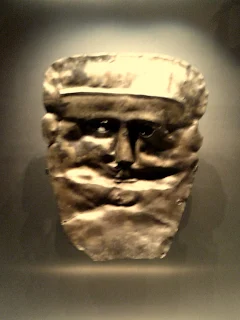





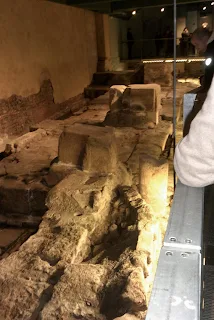










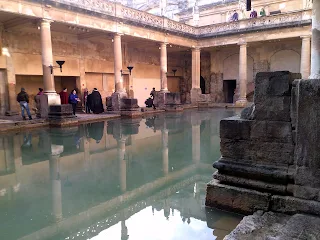



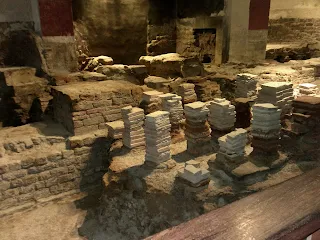



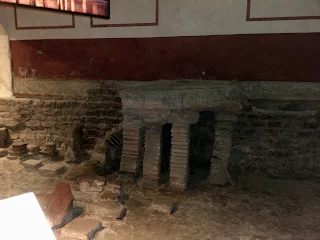







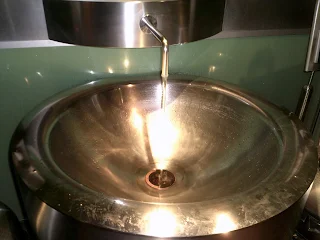

No comments:
Post a Comment